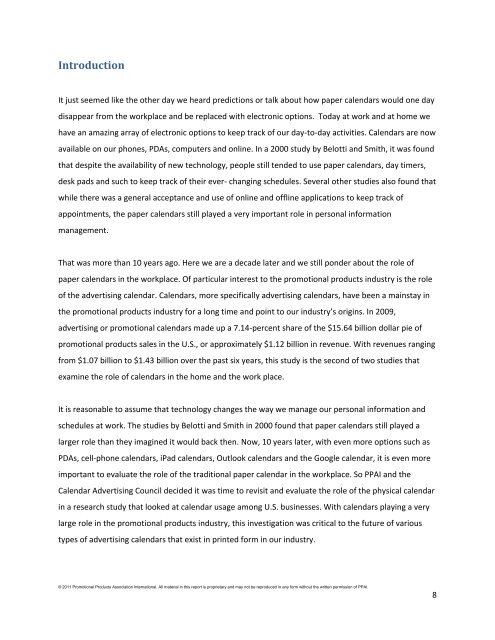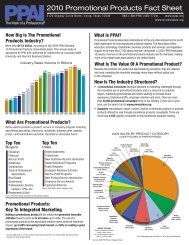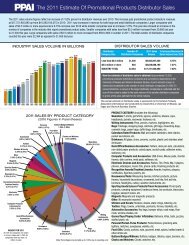A Study Of Calendar Usage In The Workplace 2011 - Promotional ...
A Study Of Calendar Usage In The Workplace 2011 - Promotional ...
A Study Of Calendar Usage In The Workplace 2011 - Promotional ...
You also want an ePaper? Increase the reach of your titles
YUMPU automatically turns print PDFs into web optimized ePapers that Google loves.
<strong>In</strong>troduction<br />
It just seemed like the other day we heard predictions or talk about how paper calendars would one day<br />
disappear from the workplace and be replaced with electronic options. Today at work and at home we<br />
have an amazing array of electronic options to keep track of our day‐to‐day activities. <strong>Calendar</strong>s are now<br />
available on our phones, PDAs, computers and online. <strong>In</strong> a 2000 study by Belotti and Smith, it was found<br />
that despite the availability of new technology, people still tended to use paper calendars, day timers,<br />
desk pads and such to keep track of their ever‐ changing schedules. Several other studies also found that<br />
while there was a general acceptance and use of online and offline applications to keep track of<br />
appointments, the paper calendars still played a very important role in personal information<br />
management.<br />
That was more than 10 years ago. Here we are a decade later and we still ponder about the role of<br />
paper calendars in the workplace. <strong>Of</strong> particular interest to the promotional products industry is the role<br />
of the advertising calendar. <strong>Calendar</strong>s, more specifically advertising calendars, have been a mainstay in<br />
the promotional products industry for a long time and point to our industry’s origins. <strong>In</strong> 2009,<br />
advertising or promotional calendars made up a 7.14‐percent share of the $15.64 billion dollar pie of<br />
promotional products sales in the U.S., or approximately $1.12 billion in revenue. With revenues ranging<br />
from $1.07 billion to $1.43 billion over the past six years, this study is the second of two studies that<br />
examine the role of calendars in the home and the work place.<br />
It is reasonable to assume that technology changes the way we manage our personal information and<br />
schedules at work. <strong>The</strong> studies by Belotti and Smith in 2000 found that paper calendars still played a<br />
larger role than they imagined it would back then. Now, 10 years later, with even more options such as<br />
PDAs, cell‐phone calendars, iPad calendars, Outlook calendars and the Google calendar, it is even more<br />
important to evaluate the role of the traditional paper calendar in the workplace. So PPAI and the<br />
<strong>Calendar</strong> Advertising Council decided it was time to revisit and evaluate the role of the physical calendar<br />
in a research study that looked at calendar usage among U.S. businesses. With calendars playing a very<br />
large role in the promotional products industry, this investigation was critical to the future of various<br />
types of advertising calendars that exist in printed form in our industry.<br />
© <strong>2011</strong> <strong>Promotional</strong> Products Association <strong>In</strong>ternational. All material in this report is proprietary and may not be reproduced in any form without the written permission of PPAI.<br />
8








